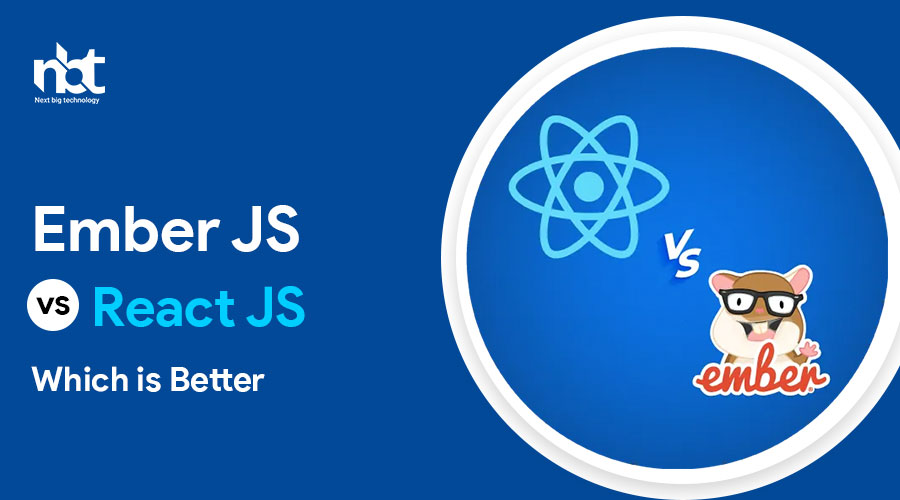Table of Contents
Introduction to Ember JS and React JS
In the vast landscape of web development, choosing the right JavaScript framework is crucial for building robust and scalable web applications. Two popular choices among developers are Ember.js and React.js. Both frameworks have their strengths and weaknesses, making them suitable for different project requirements. In this article, we’ll delve into the fundamentals of Ember.js and React.js, helping you understand their key features, use cases, and considerations for selecting the ideal framework for your next project.
Understanding Ember.js:
Ember.js is an open-source JavaScript framework that follows the model-view-viewmodel (MVVM) pattern. It is designed to help developers build ambitious web applications by providing a structured and opinionated approach to application development. One of Ember.js’s key strengths is its convention over configuration philosophy, which promotes consistency and reduces boilerplate code.
Key Features of Ember.js:
- Two-Way Data Binding: Ember.js facilitates seamless synchronization between the model and view layers of an application, allowing for real-time updates to the UI based on data changes.
- Routing: Ember.js comes with a powerful routing system that enables developers to define application routes and map them to corresponding UI components.
- Components: Ember.js promotes the use of reusable UI components, making it easier to build modular and maintainable applications.
- Ember CLI: Ember CLI is a command-line tool that streamlines the development workflow by providing generators, build tools, and project scaffolding.
Understanding React.js:
React.js, developed by Facebook, is a declarative and component-based JavaScript library for building user interfaces. It follows the principles of reactive programming, allowing developers to create dynamic UIs with minimal effort. React.js is known for its simplicity, performance, and vast ecosystem of third-party libraries and tools.
Key Features of React.js:
- Virtual DOM: React.js uses a virtual DOM to efficiently update the UI by calculating the minimal number of DOM manipulations needed.
- Component-Based Architecture: React.js promotes the composition of UIs into reusable and composable components, making it easy to build complex interfaces.
- JSX Syntax: React.js utilizes JSX, a syntax extension that allows developers to write HTML-like code within JavaScript, making the creation of UI components more intuitive.
- Unidirectional Data Flow: React.js enforces a unidirectional data flow, where data flows from parent to child components, making it easier to reason about state management.
Choosing the Right Framework:
When deciding between Ember.js and React.js for your project, consider the following factors:
- Project Requirements: Assess the complexity and scale of your project, as well as the specific features and functionality it requires.
- Developer Experience: Evaluate your team’s familiarity and expertise with each framework, as well as the availability of resources and community support.
- Performance Considerations: Consider the performance implications of each framework, including rendering speed, memory usage, and scalability.
- Ecosystem and Tooling: Explore the available ecosystem of libraries, plugins, and tools for each framework, as well as the development workflow and productivity gains offered by associated tools such as Ember CLI and Create React App.
History and Background of Ember JS
Ember.js, a powerful JavaScript framework, has become synonymous with robust web application development. Its history and background unveil a fascinating journey through the evolution of web development tools and practices.
Evolution of Web Development Tools: The early 2000s witnessed a surge in web applications, demanding more sophisticated tools for development. JavaScript emerged as a crucial component for enhancing user experiences on the web. However, building complex applications solely with JavaScript led to codebase clutter and maintenance challenges.
In response to these challenges, developers began exploring the concept of MVC (Model-View-Controller) architecture for organizing code. Frameworks like Backbone.js and AngularJS gained popularity for providing structure to web applications.
Birth of Ember.js: Ember.js, originally known as SproutCore 2.0, was born out of the desire to address the shortcomings of existing frameworks. It was officially released in December 2011 by Yehuda Katz and Tom Dale. Drawing inspiration from both Backbone.js and Ruby on Rails, Ember.js aimed to offer developers a more opinionated and productive way of building web applications.
Principles and Features: Ember.js embodies several core principles that guide its development philosophy
- Convention over Configuration: Ember.js promotes sensible defaults and conventions, reducing the need for explicit configuration.
- Stability without Stagnation: The framework prioritizes long-term stability while embracing changes and improvements in web development practices.
- Productivity: Ember.js prioritizes developer productivity by offering a rich set of tools and features out of the box.
Key Features of Ember.js:
- Two-Way Data Binding: Ember.js facilitates seamless synchronization of data between the model and the view, simplifying complex UI interactions.
- Routing: The framework provides a powerful routing system for managing application states and URLs, enabling developers to create single-page applications (SPAs) effortlessly.
- Handlebars Templates: Ember.js leverages Handlebars, a templating language, for building dynamic and reusable UI components.
- Computed Properties: Developers can define computed properties that automatically update based on changes in underlying data, enhancing application responsiveness.
Community and Ecosystem: Ember.js boasts a vibrant and supportive community of developers who contribute to its growth and evolution. The framework’s official website offers extensive documentation, guides, and tutorials to help developers get started and master advanced concepts.
Furthermore, Ember.js enjoys a rich ecosystem of add-ons and plugins, providing solutions for common development tasks and integrations with other libraries and frameworks.
Performance Comparison: Ember JS vs React JS
In the ever-evolving landscape of web development, choosing the right JavaScript framework can significantly impact the performance and scalability of your application. Among the myriad of options available, Ember.js and React.js stand out as two powerful contenders. Both frameworks offer unique features and capabilities, but when it comes to performance, how do they stack up against each other? Let’s delve into a comprehensive performance comparison of Ember.js and React.js to help you make an informed decision for your next project.
Understanding Ember.js and React.js: Ember.js and React.js are both popular JavaScript frameworks used for building modern web applications. While React.js is developed and maintained by Facebook, Ember.js is an open-source framework with a strong focus on productivity and developer ergonomics.
React.js, known for its component-based architecture, allows developers to build reusable UI components, making it easier to manage complex user interfaces. On the other hand, Ember.js follows the convention over configuration principle, providing a structured and opinionated approach to web development.
Performance Metrics: When evaluating the performance of JavaScript frameworks, several key metrics come into play, including rendering speed, memory usage, and time to interactive (TTI). Let’s compare how Ember.js and React.js fare in each of these areas:
- Rendering Speed: Rendering speed plays a crucial role in determining the responsiveness and fluidity of web applications. React.js utilizes a virtual DOM (Document Object Model), which efficiently updates only the components that have changed, resulting in fast rendering performance. Ember.js, while also employing a virtual DOM, may exhibit slightly slower rendering speeds due to its additional layers of abstraction.
- Memory Usage: Memory usage is another critical factor, especially for large-scale applications handling extensive data sets. React.js is known for its lightweight footprint, with minimal memory overhead, making it suitable for memory-constrained environments. Ember.js, while generally efficient, may consume slightly more memory due to its comprehensive feature set and built-in conventions.
- Time to Interactive (TTI): The time to interactive (TTI) measures how long it takes for a web page to become fully interactive, allowing users to interact with elements seamlessly. React.js excels in optimizing TTI by prioritizing critical rendering paths and lazy loading non-essential components. Ember.js, while proficient in optimizing application boot-up times, may require additional configuration to achieve optimal TTI performance.
Learning Curve Ember JS vs React JS
In the dynamic world of web development, staying abreast of the latest frameworks and technologies is paramount. Among the plethora of options available, Ember JS and React JS stand out as two prominent contenders, each offering unique advantages and challenges. For developers embarking on a journey to master these frameworks, understanding their learning curves is essential. In this article, we’ll delve into the nuances of learning Ember JS and React JS, offering insights to help you make an informed choice.
Understanding Ember JS:
Ember JS is an open-source JavaScript framework renowned for its convention over configuration approach. It provides developers with a structured and opinionated framework, emphasizing productivity and scalability. The learning curve of Ember JS can be described as steep initially but rewarding in the long run.
Learning Resources:
- Official Documentation: The Ember JS documentation serves as an exhaustive resource, covering everything from basic concepts to advanced topics.
- Ember CLI: Mastering Ember CLI is crucial for efficient project setup and management. Numerous tutorials and guides are available online to aid in this process.
- Community Support: Engaging with the vibrant Ember JS community through forums, meetups, and online discussions can accelerate the learning process and provide valuable insights.
Challenges:
- Convention Over Configuration: While Ember’s conventions promote consistency and best practices, they can be overwhelming for beginners accustomed to more flexibility.
- Initial Setup: Setting up a new Ember project with Ember CLI may pose challenges due to its opinionated nature and extensive folder structure.
- Learning Curve Plateau: Progressing beyond the basics in Ember JS may require a deeper understanding of its underlying concepts, leading to a plateau in the learning curve.
Exploring React JS:
React JS, developed by Facebook, has gained widespread popularity for its component-based architecture and virtual DOM. It offers developers the flexibility to build interactive user interfaces efficiently. The learning curve of React JS is characterized by its modular approach and extensive ecosystem.
Learning Resources:
- Official Documentation: React’s official documentation is comprehensive and beginner-friendly, providing step-by-step guidance on core concepts and best practices.
- React Community: The React community is vast and active, offering an abundance of tutorials, blogs, and open-source projects to aid in learning and troubleshooting.
- React DevTools: Utilizing tools like React DevTools can enhance productivity by allowing developers to inspect and debug React components seamlessly.
Challenges:
- JSX Syntax: Understanding JSX, React’s syntax extension for JavaScript, may pose an initial hurdle for developers accustomed to traditional HTML templating.
- State Management: Managing state in complex React applications can be challenging, especially for beginners. Familiarizing oneself with state management libraries like Redux or Context API is essential.
- Ecosystem Complexity: React’s extensive ecosystem, comprising libraries like Redux, React Router, and Material-UI, can be overwhelming for newcomers, requiring careful navigation and understanding of dependencies.
Community Support and Ecosystem: Ember JS vs React JS
In the ever-evolving landscape of web development, choosing the right framework can be a pivotal decision. Among the plethora of options available, Ember.js and React.js stand out as two prominent choices. While both are powerful JavaScript frameworks, they differ significantly in terms of their community support and ecosystem. Let’s delve deeper into the comparison between Ember.js and React.js in these aspects.
Community Support: Community support plays a vital role in the success and growth of any technology. In this regard, React.js has gained immense popularity over the years, largely due to its strong community backing. With a vast number of developers actively contributing to the React ecosystem, users benefit from a wealth of resources, including documentation, tutorials, forums, and third-party libraries. The extensive community support ensures that developers have access to solutions and assistance for various issues and challenges encountered during development.
On the other hand, while Ember.js may not boast the same level of widespread adoption as React.js, it still maintains a dedicated community of developers who are passionate about the framework. Despite being smaller in size compared to React’s community, the Ember.js community is known for its cohesiveness and commitment to the framework’s growth. Users can find ample support through official documentation, community forums, meetups, and dedicated Slack channels. Additionally, Ember’s long-term support (LTS) releases provide stability and reliability for enterprise applications.
Ecosystem: The ecosystem surrounding a framework encompasses a wide range of tools, libraries, plugins, and extensions that enhance its functionality and productivity. React.js, being backed by Facebook, enjoys a robust ecosystem that is continuously evolving. Developers have access to a plethora of third-party libraries and tools such as Redux, React Router, and Material-UI, which augment the development process and enable building complex applications with ease. Moreover, the flexibility of React.js allows for seamless integration with other libraries and frameworks, offering developers the freedom to choose the tools that best suit their project requirements.
State Management: Ember JS vs React JS
In comparison, Ember.js follows a more opinionated approach, providing a curated set of tools and conventions out of the box. The Ember ecosystem includes Ember Data for managing data persistence, Ember CLI for project scaffolding and build automation, and Ember Inspector for debugging applications. While Ember.js offers a comprehensive set of tools for rapid application development, some developers may find the framework’s strict conventions limiting, especially when integrating third-party libraries or custom solutions.
In the ever-evolving landscape of web development, choosing the right framework is crucial for building robust and efficient applications. Two popular contenders in this arena are Ember.js and React.js, each offering distinct approaches to state management. Let’s delve into a comparative analysis to understand how these frameworks handle state management and which one might be the better fit for your project.
Understanding State Management: Before we compare Ember.js and React.js, let’s grasp the concept of state management. In web development, state refers to any data that can change over time. State management involves handling and updating this data to ensure that the user interface remains synchronized with the underlying data.
Ember.js: Convention Over Configuration: Ember.js is renowned for its convention over configuration approach, which simplifies development by providing a set of predefined conventions. In Ember.js, state management is primarily handled through controllers and services. Controllers manage the state of individual routes, while services handle global state shared across multiple components.
Ember’s data-down, actions-up (DDAU) approach ensures that data flows unidirectionally, simplifying state management and enhancing predictability. Additionally, Ember Data, the built-in data management library, facilitates seamless integration with backend APIs, further streamlining state management tasks.
React.js: Declarative and Component-Based:
React.js, on the other hand, embraces a declarative and component-based paradigm, making it highly efficient for building dynamic user interfaces. In React, state management revolves around component state and props. Each component can maintain its state, which can be modified using the setState() method.
React’s unidirectional data flow and virtual DOM enable efficient updates to the UI based on changes in state. While React core doesn’t prescribe a specific state management solution, popular libraries like Redux and MobX are commonly used to manage state in larger applications, offering centralized stores and predictable state management.
Choosing the Right Framework:
When it comes to selecting between Ember.js and React.js for state management, several factors come into play:
- Project Size and Complexity: Ember.js, with its conventions and built-in solutions, might be preferable for larger projects with complex state management requirements. React.js, with its flexible ecosystem, is well-suited for projects of varying sizes and architectures.
- Developer Experience: Ember.js’ convention over configuration approach can accelerate development, especially for teams familiar with its conventions. React.js provides greater flexibility but might require more initial setup and configuration.
- Community and Ecosystem: React.js boasts a larger community and ecosystem, with numerous third-party libraries and tools available for state management. Ember.js, while not as extensive, offers a more curated ecosystem with officially supported solutions.
Component Architecture: Ember JS vs React JS
In the realm of modern web development, selecting the right framework can significantly impact the success of a project. Two prominent contenders in this arena are Ember.js and React.js, both renowned for their robust component-based architectures. In this comparative analysis, we delve into the intricacies of component architecture in Ember.js and React.js to discern their strengths, weaknesses, and suitability for various development scenarios.
Understanding Component Architecture: Both Ember.js and React.js embrace the concept of component-based architecture, which involves breaking down user interfaces into reusable, self-contained modules. These components encapsulate both the structure and behavior of UI elements, promoting modularity, maintainability, and scalability in web applications.
Ember.js: Ember.js, an opinionated JavaScript framework, offers a convention-over-configuration approach, streamlining the development process. In Ember.js, components are defined using Handlebars templates, allowing developers to create custom HTML-like elements effortlessly. The framework’s built-in conventions ensure consistency across projects, enhancing productivity and reducing cognitive overhead.
One of Ember.js’s notable features is its data-down, actions-up (DDAU) architecture, facilitating uni-directional data flow within components. This paradigm simplifies state management and debugging, promoting predictability and stability in complex applications. Additionally, Ember.js provides a rich ecosystem of addons and tools, further augmenting developer productivity and project scalability.
React.js: React.js, developed by Facebook, has gained widespread adoption for its declarative and composable nature. In React.js, components are defined as JavaScript functions or classes, enabling developers to create dynamic and interactive user interfaces efficiently. The framework’s virtual DOM abstraction optimizes rendering performance, ensuring smooth user experiences even in resource-intensive applications.
React.js embraces a uni-directional data flow pattern, where data flows from parent to child components via props. This simplicity enhances code maintainability and facilitates the creation of reusable components. Furthermore, React.js’s extensive ecosystem, including libraries like Redux and GraphQL, empowers developers to address diverse use cases with ease.
Comparative Analysis:
When comparing Ember.js and React.js in terms of component architecture, several factors come into play:
- Developer Experience: Ember.js’s convention-over-configuration approach simplifies development, particularly for teams seeking structure and consistency. In contrast, React.js offers greater flexibility and freedom, appealing to developers who prioritize customization and control.
- Performance: Both frameworks excel in rendering performance, thanks to their efficient virtual DOM implementations. However, React.js’s lightweight nature and fine-grained control over component lifecycle often result in superior performance, especially in applications with complex UIs.
- Community and Ecosystem: React.js boasts a larger and more active community, along with a vast ecosystem of third-party libraries and tools. While Ember.js offers robust support and documentation, its ecosystem may not be as extensive as React.js’s, potentially limiting options for specialized use cases.
- Learning Curve: Ember.js’s opinionated nature may steepen the initial learning curve for developers transitioning to the framework. On the other hand, React.js’s modular design and intuitive syntax make it more approachable for beginners, albeit requiring a deeper understanding of JavaScript fundamentals.
Tooling and Development Environment: Ember JS vs React JS
In the dynamic landscape of web development, choosing the right framework is crucial for building robust and efficient applications. Among the plethora of options available, Ember JS and React JS stand out as popular choices, each with its own set of advantages and characteristics. In this guide, we’ll delve into the tooling and development environments of Ember JS and React JS to help you make an informed decision.
Understanding Ember JS: Ember JS is an open-source JavaScript framework that follows the convention over configuration (CoC) paradigm. It provides developers with a structured approach to building single-page web applications. Ember’s core philosophy revolves around productivity, stability, and developer ergonomics.
Tooling: Ember CLI (Command Line Interface) serves as the primary tool for developing Ember applications. It offers a set of commands for generating components, routes, controllers, and more, streamlining the development process. Furthermore, Ember Data provides a powerful data management library for interacting with backend APIs seamlessly.
Development Environment: Ember’s development environment emphasizes convention and consistency. With its strong opinions on project structure and best practices, developers can quickly get up to speed and collaborate efficiently. The Ember Inspector browser extension offers valuable insights into the application’s state, making debugging and performance optimization easier.
Understanding React JS: React JS, developed by Facebook, is a declarative, efficient, and flexible JavaScript library for building user interfaces. It adopts a component-based architecture, allowing developers to compose complex UIs from reusable components. React’s virtual DOM implementation ensures optimal performance by minimizing unnecessary DOM updates.
Tooling: Create React App is a popular tool for bootstrapping React projects, providing a pre-configured development environment with webpack and Babel under the hood. Additionally, tools like React Router and Redux complement React’s ecosystem, enabling efficient routing and state management.
Development Environment: React’s development environment offers flexibility and extensibility, allowing developers to integrate with their preferred tools and libraries seamlessly. The React Developer Tools browser extension provides a suite of debugging and profiling features, empowering developers to diagnose and optimize their applications effectively.
Choosing Between Ember JS and React JS: When deciding between Ember JS and React JS, several factors come into play. Ember JS offers a more opinionated approach, which can be beneficial for teams seeking consistency and productivity. On the other hand, React JS provides greater flexibility, allowing developers to tailor their development environment to specific project requirements.
Ultimately, the choice between Ember JS and React JS depends on your project’s needs, team dynamics, and long-term goals. Both frameworks have thriving communities, extensive documentation, and robust ecosystems to support your development journey.
Industry Adoption and Use Cases: Ember JS vs React JS
In the realm of web development, selecting the right JavaScript framework can significantly impact the success of a project. Two prominent contenders in this arena are Ember.js and React.js. Both frameworks offer robust solutions for building modern web applications, but they differ in their approach and features. In this article, we’ll delve into the industry adoption and use cases of Ember.js and React.js to help you make an informed decision for your next project.
Industry Adoption: Ember.js, initially released in 2011, gained popularity for its convention over configuration approach, which emphasizes productivity and scalability. Over the years, it has garnered a loyal following, particularly in large-scale enterprise applications. Companies like LinkedIn, Netflix, and Intercom have embraced Ember.js for its stability and extensive ecosystem.
On the other hand, React.js, developed by Facebook in 2013, has witnessed explosive growth and widespread adoption. Its component-based architecture and virtual DOM make it highly efficient for building interactive user interfaces. React.js has been adopted by tech giants such as Facebook, Instagram, and Airbnb, along with a vast community of developers worldwide.
Use Cases: Ember.js excels in projects that prioritize structure and maintainability. Its strong conventions streamline development workflows, making it ideal for teams working on large, complex applications. Industries such as fintech, e-commerce, and content management systems benefit from Ember.js’s robust framework and built-in solutions for common challenges.
React.js, with its focus on building reusable UI components, shines in applications requiring frequent updates and dynamic content. It is well-suited for single-page applications, real-time data visualization, and mobile app development. Industries like social media, travel, and online gaming leverage React.js to deliver immersive user experiences across various platforms.
Comparison: When comparing Ember.js and React.js, it’s essential to consider factors such as developer experience, performance, and ecosystem support. Ember.js provides a more structured environment out of the box, which can accelerate development for teams familiar with its conventions. React.js offers greater flexibility and a vibrant ecosystem of libraries and tools, empowering developers to tailor solutions to specific project requirements.
Future Outlook and Updates: Ember JS vs React JS
In the dynamic landscape of web development, two prominent JavaScript frameworks stand out: Ember JS and React JS. Both have carved their niches, offering developers powerful tools to create stunning web applications. However, as technology evolves and user demands shift, it’s crucial to explore the future outlook and updates of these frameworks to make informed decisions. Let’s delve into the comparison between Ember JS and React JS and assess their trajectories in the ever-changing tech sphere.
Ember JS:
Ember JS has been known for its robust architecture and conventions that streamline the development process. With its “convention over configuration” approach, Ember provides developers with a structured environment, making it easier to build complex applications. One of the significant updates on the horizon for Ember is its renewed focus on performance enhancements and improved developer experience.
The Ember team is continuously working on updates to optimize rendering speeds and reduce bundle sizes, ensuring that applications built with Ember remain competitive in terms of performance. Moreover, efforts are underway to simplify the learning curve for newcomers and enhance the documentation to facilitate smoother onboarding.
Another aspect that sets Ember apart is its commitment to stability and long-term support. This focus on backward compatibility instills confidence in developers, assuring them that their projects will remain viable and well-supported over time. As Ember evolves, it aims to strike a balance between innovation and stability, catering to both seasoned developers and newcomers alike.
React JS:
React JS, backed by Facebook, has revolutionized the way developers approach front-end development. Its component-based architecture and virtual DOM offer unparalleled flexibility and efficiency. Looking ahead, React is poised to maintain its position as a frontrunner in the JavaScript ecosystem with several exciting updates in the pipeline.
One of the most anticipated developments is the release of React 18, which promises concurrent rendering and improved server-side rendering capabilities. These enhancements are geared towards enhancing the performance of React applications, especially in high-traffic scenarios. Additionally, React continues to invest in tools like React Native for building cross-platform mobile applications, further expanding its reach beyond the web.
Moreover, React’s vibrant ecosystem ensures that developers have access to a plethora of libraries, tools, and resources to streamline their workflow. From state management solutions like Redux to testing frameworks like Jest, React fosters a thriving community that contributes to its growth and adaptability.
Future Outlook:
As we look towards the future, both Ember JS and React JS are poised to continue thriving in the ever-evolving landscape of web development. While Ember emphasizes convention and stability, React champions flexibility and performance. Ultimately, the choice between the two frameworks depends on factors such as project requirements, team expertise, and long-term goals.
Developers must stay abreast of the latest updates and trends in the JavaScript ecosystem to make informed decisions and leverage the strengths of each framework effectively. Whether you opt for the structured approach of Ember JS or the flexibility of React JS, the future promises exciting opportunities for innovation and growth in web development.
Top Ember JS vs React JS Development Companies
In the ever-evolving landscape of web development, choosing the right technology stack is crucial for the success of your project. Among the plethora of options available, Ember.js and React.js stand out as two of the most popular choices for building dynamic and interactive web applications. Both frameworks have their strengths and weaknesses, and selecting the right one depends on various factors such as project requirements, scalability, performance, and community support.
To help you make an informed decision, we’ve curated a list of top development companies specializing in Ember.js and React.js. These companies have demonstrated expertise, innovation, and a track record of delivering exceptional solutions to clients worldwide.
-
Next Big Technology:

Focus Area
- Mobile App Development
- App Designing (UI/UX)
- Software Development
- Web Development
- AR & VR Development
- Big Data & BI
- Cloud Computing Services
- DevOps
- E-commerce Development
Industries Focus
- Art, Entertainment & Music
- Business Services
- Consumer Products
- Designing
- Education
- Financial & Payments
- Gaming
- Government
- Healthcare & Medical
- Hospitality
- Information Technology
- Legal & Compliance
- Manufacturing
- Media
Top Ember.js Development Companies:
- DockYard: DockYard is a digital product agency that specializes in Ember.js development. With a team of experienced developers, designers, and engineers, they have delivered cutting-edge solutions to startups and enterprises alike. Their commitment to quality and innovation has earned them a reputation as one of the top Ember.js development companies in the industry.
- Tilde Inc.: Tilde Inc. is the company behind the development of Ember.js. As such, they possess unparalleled expertise in the framework and offer comprehensive development services to clients. Whether it’s building complex web applications or providing training and support, Tilde Inc. is a trusted partner for Ember.js projects of any scale.
- Simplabs: Simplabs is a software consultancy firm that specializes in Ember.js development. They offer end-to-end services, including consulting, design, development, and support, to help clients leverage the full potential of the framework. With a focus on simplicity, performance, and maintainability, Simplabs has earned the trust of numerous clients worldwide.
Top React.js Development Companies:
- ThoughtWorks: ThoughtWorks is a global technology consultancy known for its expertise in React.js development. They have a team of highly skilled developers who excel in building scalable and feature-rich web applications using React.js. With a client-centric approach and a commitment to delivering value, ThoughtWorks ranks among the top React.js development companies globally.
- Netguru: Netguru is a leading software development company that offers specialized services in React.js development. They have a proven track record of delivering successful projects for clients across various industries, ranging from startups to Fortune 500 companies. With a focus on innovation and agility, Netguru is a preferred choice for businesses seeking React.js expertise.
- Brainhub: Brainhub is a software development agency that specializes in React.js development. They offer a full range of services, including consulting, design, development, and support, to help clients build exceptional web applications. With a focus on collaboration and transparency, Brainhub ensures that clients are involved in every step of the development process.
FAQs On Ember JS vs React JS Development
Are you torn between Ember JS and React JS for your next development project? Making the right choice between these two popular JavaScript frameworks can significantly impact your project’s success. To help you make an informed decision, let’s address some frequently asked questions about Ember JS and React JS development.
- What is Ember JS and React JS?
- Ember JS: Ember is an open-source JavaScript framework that follows the Model-View-ViewModel (MVVM) pattern. It provides developers with a structured framework for building ambitious web applications.
- React JS: React, developed by Facebook, is a declarative, efficient, and flexible JavaScript library for building user interfaces. It follows the component-based architecture, allowing developers to create reusable UI components.
- Which one is easier to learn?
- React JS tends to have a shallower learning curve compared to Ember JS. React’s simplicity and focus on reusable components make it easier for beginners to grasp its concepts and start building applications quickly.
- Which framework offers better performance?
- Both Ember JS and React JS are known for their excellent performance. However, React’s virtual DOM (Document Object Model) makes it particularly efficient in updating the UI and managing large datasets, which can lead to better overall performance in certain scenarios.
- Which framework has better community support?
- React JS boasts a larger and more active community compared to Ember JS. The vast community support translates to extensive documentation, a wide range of third-party libraries, and numerous tutorials and resources available for developers.
- Which one is more suitable for enterprise-level applications?
- Ember JS is often preferred for large-scale enterprise applications due to its convention-over-configuration approach and built-in features like Ember Data for managing data persistence. It provides a more opinionated structure, making it easier for teams to collaborate and maintain consistency in large codebases.
- Which framework is better for SEO?
- Both Ember JS and React JS can be made SEO-friendly with server-side rendering (SSR) or pre-rendering techniques. However, React JS has gained popularity for its ability to render on the server using libraries like Next.js, making it easier to achieve good SEO performance out of the box.
- Which framework offers better tooling and ecosystem?
- React JS has a more extensive ecosystem and a broader range of tools and libraries available, thanks to its large and active community. Additionally, React’s component-based architecture encourages the development of reusable components, further enhancing productivity.
- Which framework is more future-proof?
- Both Ember JS and React JS have proven to be robust and adaptable frameworks, with active development communities continuously improving them. However, React’s flexibility and the backing of Facebook and a vast community make it a solid choice for long-term projects.
Thanks for reading our post “Ember JS vs React JS Which is Better”. Please connect with us to learn more about Ember JS vs React JS Development.















